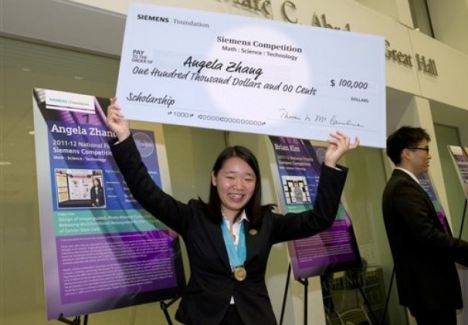
High school student Angela Zhang from Cupertino, California, has found a possible cure for cancer and she has been rewarded with a scholarship for $100,000.
Angela Zhang, 17, a first generation Chinese schoolgirl, who is learning to drive, seems in many ways an average Californian teenager, CBS News reported.
When Angela Zhang shared a project she had created in her spare time with her Monta Vista High School, chemistry teacher, Kavita Gupta it was the beginning of an extraordinary sequence of events.
The project, an advanced research paper detailing a method for curing cancer, was beyond her teacher.
“Cure for cancer – a high school student,” Kavita Gupta told CBS.
“It’s just so mind-boggling. I just cannot even begin to comprehend how she even thought about it or did this.”
Angela Zhang had always been precocious. As a freshman, she read doctorate level papers on bio-engineering.
In sophomore year she’d talked her way into the lab at Stanford, and by junior year she was doing her own research on the project.
“I just thought, <<Why not? What is there to lose?>>” said Angela Zhang.
“At first it was a little bit overwhelming,” she said, “but I found that it almost became like a puzzle, being able to decode something.”

Angela Zhang’s idea was to mix cancer medicine in a polymer that would attach to nanoparticles. These nanoparticles would then fasten themselves to cancer cells and show up on an MRI allowing doctors to exactly where tumors are.
An infrared light aimed at the tumours would melt the polymer and release the medicine, killing the cancer cells while leaving healthy cells unharmed.
When tested on mice the tumours almost completely disappeared. Although it will be years before scientist will be able to run tests on humans, the results do seem promising.
Meanwhile Angela Zhang’s paper won her the national Siemens science contest, netting the teen $100,000.
“This is a Cinderella moment for a science nerd like me,” Angela Zhang told the Mercury News.
“I’m excited to learn just everything possible,” she said.
“Everything in the sciences – biology, chemistry, physics, engineering, even computer science – to make new innovations possible.”